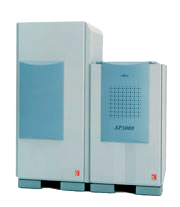The Fujitsu AP3000 was a scalar-parallel supercomputer. Instead of using vector processing units, the AP3000 derived its high-speed performance from its distributed-memory parallel server construction that gave superb performance scalability by linking general-purpose workstations together with a high-speed network. Fujitsu announced the AP3000 in March 1996 as the successor to the AP1000, a supercomputer that operated on the same principle. The AP3000’s most distinctive feature was the newly developed high-speed AP-NET communication network, which linked as many as 1,024 nodes, where each node was a workstation with a 64-bit UltraSPARC architecture. AP-NET was a network with a 2D torus topology and was built with routing controller LSIs that relayed messages.
- Features of the AP-NET:
- (1) High-speed data transfers on the order of 200 MB/s per port
- (2) Wormhole routing
- (3) Two-way virtual communication channels
- (4) Barrier synchronization between nodes
- (5) RAS functions
| Introduced | March 1996 |
|---|---|
| No. of nodes | 4 — 1024 |
| Node types | Three (U140, U170, U200) |
| Memory capacity | 128 MB — 2 TB |
| Internal disk capacity | 8.4 GB — 4.2 TB |
| Node-connecting network | AT-Net (200 MB/s, bidirectional) |
| External network interfaces | Ethernet, Fast Ethernet, FDDI, ATM, etc. |
| Connectable peripheral devices | Disk arrays, tape libraries, etc. |
| Operating system | Solaris, Japanese edition |
| Node type | U140 | U170 | U200 |
|---|---|---|---|
| No. of CPUs | 1 | 1 — 2 | |
| Processing element | UltraSPARC (64 bits, 143 MHz) |
UltraSPARC (64 bits, 167 MHz) |
UltraSPARC (64 bits, 200 MHz) |
| Cache memory per CPU | Internal:32KB External:512KB |
Internal:32KB External:1MB |
|
| Internal | 32MB — 1GB | 64MB — 1GB | 64MB — 2GB |
| Internal disk capacity | 2.1GB — 4.2GB | 4.2GB | |
The specifications above were correct at the time the products were announced. Some specifications were later revised due to product upgrades.


